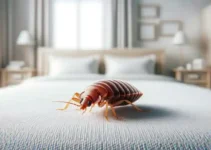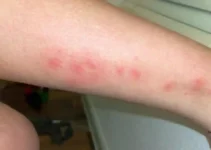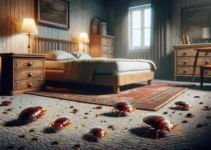This publication explains how to get rid of bed bugs in one day. The mere mention of bed bugs makes most people cringe. No homeowner wants to deal with bed bug problems, from finding them to how challenging eliminating them can be.
How the bed bugs infested in the first place
Often, they tend to enter a home in the form of hidden stowaways. If you recently visited someone’s home or a hotel with bed bugs, or if your kids had been to school, chances are that some of these ferocious bugs are in your luggage, backpack, or clothes.
Immediately after you return home, bed bugs would come out of their travel hideouts to live anywhere in your home they consider comfortable.
Mattresses are a known nesting place for bed bugs, but you’d also find them often behind draperies, dug into thick carpeting, or hiding among your clothes—if at all you’ll even find them.
Bed bugs have an excellent way of hiding—they tuck themselves into gaps and creases, which doesn’t only make it challenging to find but also much more challenging to locate and eliminate them.
Signs of bed bugs in your home
Common signs of bed bugs include:
- black droppings or shed skins on your mattress seams or other places;
- an offensive musty odor around your bed or in the home sometimes called a locker room smell. Some people say at low concentrations it’s a pleasant smell—like coriander—Scientific American;
- bites, welts, or bumps on your body after getting out of bed; and
- tiny blood stains on your pillowcases or sheets.
Do chemical products remove bed bugs in 24 hours?
When bed bugs are identified, most homeowners want to eliminate them as fast as they can, in any way possible. They often naturally use chemical sprays and insecticides, but this only works for some bugs, not bed bugs.
Most chemical products don’t completely work to eliminate bed bugs—either the poison fails on some, you miss some, or any surviving bugs stay away until the chemicals lose potency before they return to production.
There’s only one effective way to eliminate bed bugs, which is heat treatment. Extreme heat isn’t only the most dangerous weapon against them, it also reaches into their living space, so bed bugs can’t run or hide from the effect. Even more, appropriate heat treatment will get rid of bed bugs in 24 hours.
How to get rid of bed bugs in one day
Follow the steps below to get rid of bed bugs in one day:
1. Identify the problem
Collect a pest sample to show an extension agent or other insect professional
Extension agents can readily identify pests, They have the requisite training in pest control and are versed with your local area. If the extension agent or another expert says the pest is a bed bug, you want to inform your landlord if you reside in an apartment. It could help to inspect units around you.
Landlords may be responsible for participating in the treatment. Check for any housing codes and laws in the area.
Inspect all areas that might have bed bugs, including nearby places to determine the extent of the infestation.
2. Develop an action plan
Develop a plan for executing the steps to rid bed bugs. You’d have to maintain records throughout the entire process. Note what dates and exact locations you could find them. Doing that would assist you in tracking your progress to know where’s best to concentrate your pest control efforts.
You would also have to continue checking for at least one year after you’ve executed pest control to ensure you no longer have any bed bugs.
3. Keep the infestation at bay
- Close up all the tiny hiding spaces. Use silicon caulk to seal cracks and gaps. That would remove all hiding spots and bring the bed bugs into the open area.
- Take away infested items. Place infested items in a sealed plastic bag before treating them.
- If you can treat certain items, place them in a storage container or sealed plastic bags but that will require leaving them there for up to 12 months to ensure all active bugs are dead.
- Buy protective covers to seal box springs and mattresses. These covers seal them so bed bugs get trapped within them and die.
- Vacuum after each usage. Seal bags as tightly as possible and immediately dump them in an outdoor trash can.
- Do away with furniture in a responsible way if you can’t remove the bed bugs. Destroy it so no one thinks of bringing them into their houses. For instance, you can cover and eliminate stuffing from furniture items and use spray paint to mark the furniture with “Bed Bugs”.
- Ensure the trash collection agency picks up infested items as soon as possible.
Don’t throw away furniture if you can safely remove bed bugs from it.
4. Prepare and enforce a treatment method
Preparing to treat the home against bed bugs is vital; that will make it easier to monitor bed bugs that are still lurking around. You want to complete such preparations whether you’re hiring a professional or you’re treating the home yourself.
To get rid of the bed bugs in one day, ensure you select methods that are human, safe, and effective. Stay away from ineffective treatments. Do not try to kill bed bugs with home remedies such as rubbing alcohol, kerosene, gasoline, bleach, cedar oil, or thyme oil. These home remedies will not work, and some could be dangerous to you and your family—Division of Environmental Health, Pesticide Control Program, Alaska.
a. Heat
Heat is the best way to get rid of bed bugs in your home or workspace. Good heat treatment sneaks up on bed bugs.
Bed bugs don’t react as the temperature increases slowly to nearly 120 degrees—they just sit around till the extreme heat kills them. This is why heat treatment is just really effective means of eliminating bed bugs in one day.
However, a trained professional is the one who ought to perform a heat treatment. If you suspect a bed bug infestation in the home, contact a pest control agency and request heat treatment services.
b. Use sticky traps
Sticky traps aren’t for bed bugs but might be effective to get rid of bed bugs in one day if you can locate all areas of infestation. Insecticide strips may be an option for treating smaller items that can’t be laundered such as books, luggage, or pillows. Place the items in an airtight container with insecticide strips. These strips work by releasing odorless vapors that build up inside the container over several days and kill bed bugs. Most strips contain dichlorvos (DDVP) or permethrin.
c. Cold treatment
Cold treatment might work, but they only work if you set the freezer to 00F. Many domestic refrigerator freezers may not operate at a low enough temperature to kill them. Leave the items in a sealed container in the freezer at 00F for 72 hours. Always use a thermometer in checking the temperature, since your home freezer is most likely not set to 00C.
d. Steam cleaners
Steam cleaners (wet or dry) can reach cracks and fabrics to treat baseboards, bed frames, carpets, and other furniture. Set the steam temperature to at least 1300F. However, ensure there’s no forceful airflow, or the bed bugs could scatter. A diffuser can help prevent the bed bugs from scattering.
e. Insect growth regulators
When you use an insect growth regulator, it interferes with the developmental ability of the bed bugs from nymph to reproductive adult. This method may not work in one day but is a useful method you can introduce to eliminate bed bugs in your home or workspace.
Hydroprene is one insect growth regulator labeled for bed bug control and is available in a liquid or an aerosol. Just spray it into cracks and crevices where young bed bug nymphs will come in contact.
Hydroprene kills lots of bed bugs during or shortly after molting to adulthood. However, the surviving ones can still feed, mate, and produce at least one egg batch. Thus, hydroprene products are not very reliable in controlling bed bugs, even if it is marked for bed bugs.
Stop bed bugs from returning
After cleaning, vacuuming, and following all steps to control bed bugs, consider using insecticides yourself to block bed bugs from coming back after treatment. Do the following:
- Make sure to apply silica dust to all cracks and crevices in your home;
- Only buy products that contain the active ingredients: piperonyl butoxide, imidacloprid, acetamiprid, or dinotefuran. The product you buy should have a label stating that it is to be used for bed bugs; and
- Follow the product instructions to effectively apply them to fight bed bugs in your home.
Read Also: If One Room Has Bed Bugs Do They All?


